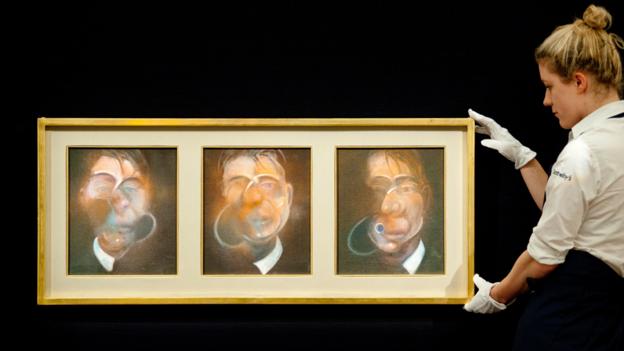
Imagine Las Vegas casino owner Steve Wynn’s horror when, seven years ago, he accidentally put his elbow through Picasso’s painting Le Rêve (The Dream), just as he was about to sell it for an eye-popping $139m.
The painting is one of a series of sensuous portraits of the artist’s young mistress Marie-Thérèse Walter, painted in 1932 during their torrid affair. Such works are among the most desirable by Picasso and the price would have set a new high for the artist – but with the painting punctured, the buyer, billionaire hedge fund mogul Steve Cohen, called off the deal.
Now, after a skillful repair, the sale has finally gone through, but this time for $150m, setting a new record for Picasso as well as being the highest price any American collector has ever paid for a work of art. This was a private sale, and at auction records are also being shattered: last year in New York, Edvard Munch’s The Scream made almost $120m.
While much of the world is mired in economic gloom, the art market – which regularly sees multi-million prices set for paintings and sculpture – seems to be living in a parallel universe. Le Rêve just one example of how values are spiralling upwards, driven by new money, newly emerged economies, speculation and a fashion for art that overlaps with lifestyle choices and the luxury goods industry.
The seemingly gravity-defying art market also reflects the nature of wealth today. The sheer amount of money in private hands allows billionaires – and there are, at the last count according to Forbes, 1,426 of them spread throughout the world – to indulge in a highly competitive sport to bag the best artworks. And after all, if you can spend nearly $1bn on a yacht, as the Russian billionaire Roman Abramovich is supposed to have spent on his floating palace Eclipse, another few millions for a trophy picture is not that much.
And while you can build another yacht, you can’t get a top Manet, Cézanne or Raphael made for you – you have to vie with other collectors when one appears on the market.
A changing picture
This is a market which has, over the last 25 years, seen a massive growth in size. According to art economist Dr Clare McAndrew, in a report published in 2012, about $27.2bn worth of art was sold through dealers and auction houses in 1990. By 2007, at the peak of the last boom, this figure had almost tripled, to $65.8bn. In 2012, according to her latest findings, it was still worth a stunning $56bn, despite shrinking slightly compared to the previous year.
As well as expanding, the business of selling art has been profoundly modified by the arrival of new economies. This is now a global market, no longer dominated by the US and Europe and by American and European artists. Just two years ago, in the grip of sometimes extravagant spending on art in mainland China – and probably aided by some optimistic reporting – China leapfrogged into the top position, with the highest total in this field. While it has now fallen back to the number two slot, China and Hong Kong still represent 25% of art sales, with only the US ahead, with 33%.
Works of art have been sold in China at levels that used to be reserved for the top Western names. For instance an 11th century calligraphy scroll by Huang Tingjian sold recently for a stunning $63.8m in Beijing.
The fashion for private and indeed state-sponsored museums has also been driving the top end of the market - Gulf states, particularly Qatar and the United Arab Emirates, have been eagerly acquiring works of art for ambitious museum programmes. The Qatari royal family, notably Sheikha Mayassa Al Thani, daughter of the Emir, has been extremely active, and is thought to be the biggest buyer in the world today. What does she buy? Mainly modern and contemporary art, and Qatar is generally thought to have paid the highest price ever for an artwork – $250m in 2011 for Cézanne’s The Card Players.
Disparity in fortunes
Buying art, for many of today’s newly wealthy, also gives access to a glamorous lifestyle. There is an endless round of art fairs, biennales, auctions and events all over the world to attend, where galleries and auction houses put on the most glittering parties. Fashion magazines, luxury goods and watch companies pile in, as well as banks, who are increasingly watching art as a new asset class. In some countries such as China or India, art buying is considered first and foremost for investment, rather than for passion or as a hobby.
The flip side of all this is polarisation, with a small crust of very rich people driving the market, pushing up prices for a handful of ’blue-chip’ artists and enriching a few big galleries and a few auction houses. Further down the scale, however, the middle and lower ends of the market are far less buoyant. So while the overall picture seems rosy, in fact it disguises increasing disparity in fortunes.
Particularly in the mid-market, some galleries are closing, and many are having a hard time. The London gallery Hotel, despite its high reputation as a cutting-edge space, went into liquidation last year. More recently, gallerists Nicole Klagsbrun in New York and Jérôme de Noirmont have started to work differently and have abandoned their showrooms.
Art, sadly, seems to have become much more of a rich man’s game. And while the appetite for big names such as Picasso and works like Le Rêve seems unquenchable for the moment, things are not necessarily so dreamy for younger and lesser-known artists.
For source go here.
No comments:
Post a Comment